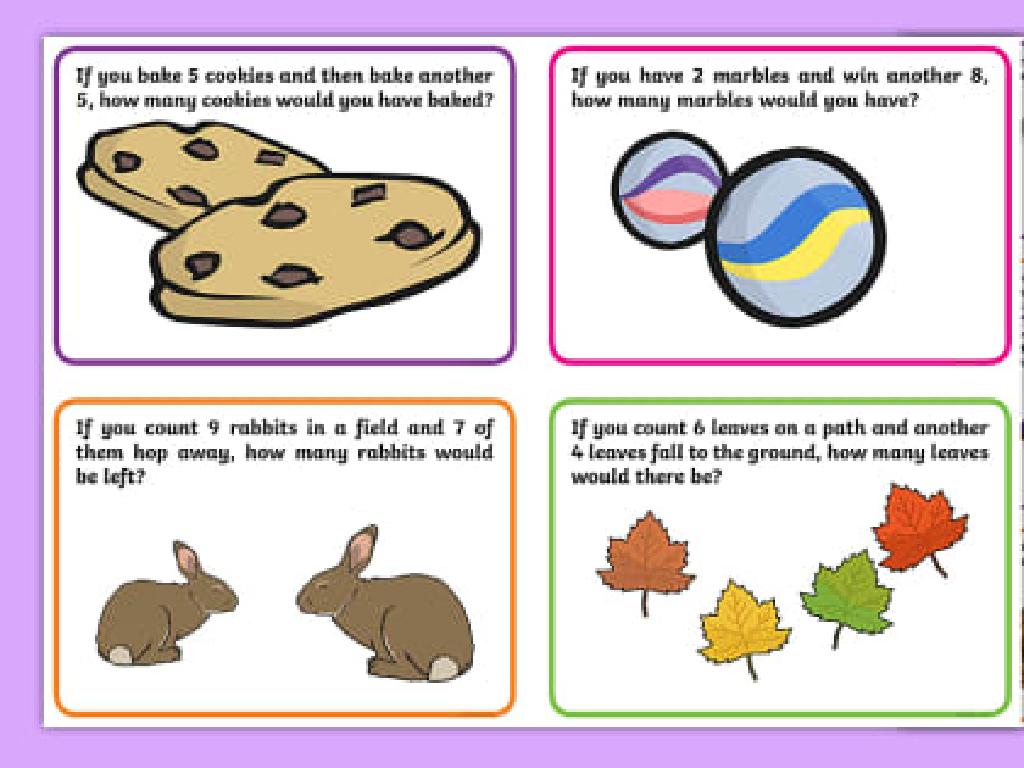Convert To/From A Number
Subject: Math
Grade: Third grade
Topic: Place Value
Please LOG IN to download the presentation. Access is available to registered users only.
View More Content
Welcome to Place Value!
– Understanding place value importance
– Numbers have different place values
– Ones, tens, hundreds: each place matters
– Each place is 10 times the right place
– If 1 is in the tens place, it’s worth 10
– Practice with place value charts
– Use a chart to see the value of each place
|
This slide introduces the concept of place value, which is fundamental in understanding how numbers are structured in our decimal system. Emphasize that each position in a number has a different value and that as we move left, each place is worth 10 times more than the place to its right. For example, in the number 345, the 5 is in the ones place, the 4 is in the tens place, and the 3 is in the hundreds place. Use a place value chart to visually represent this concept and provide examples with different numbers to illustrate how the value of a digit changes depending on its position. Encourage students to create their own examples and use manipulatives if available to reinforce the lesson.
Understanding Place Value
– What is place value?
– It’s the value of where a digit is in the number.
– Identifying place values
– Ones, tens, hundreds: what do they mean?
– Place value in numbers
– In 132, ‘3’ is in the tens place, meaning 30.
– Significance of each position
|
Place value is a fundamental concept in mathematics that helps us understand the value of digits based on their position in a number. It’s crucial for students to recognize the ones, tens, and hundreds places to build their number sense. Use the number 132 as an example to show that the ‘3’ represents 3 tens, or 30, because of its position. Emphasize that each step to the left increases the value tenfold. Encourage students to practice with different numbers and to explain the value of digits in various positions. This understanding is the building block for addition, subtraction, and beyond.
Building Numbers with Place Value
– Creating numbers with place value
– Understand units, tens, hundreds places
– Representing places with base-ten blocks
– Each block type represents a different value
– Activity: Construct 425 with blocks
– Use 4 hundreds, 2 tens, and 5 units blocks
|
This slide introduces the concept of building numbers using place value, which is fundamental in understanding the base-ten system. Start by explaining each place value position such as units, tens, and hundreds. Show how base-ten blocks can visually represent these places, with different block sizes for each place value. For the activity, guide students to use the correct number of hundreds (large blocks), tens (medium rods), and units (small cubes) to build the number 425. This hands-on activity helps solidify their understanding of how numbers are composed in the base-ten system. Prepare to assist students who may struggle with the concept and have additional examples ready for practice.
Converting Words to Numbers
– Understanding word form
– Example: Words to number
– ‘Four hundred twenty-five’ is 425
– Practice conversion
– Turn ‘Three hundred twelve’ into a number
– Discuss place value
– Each digit has a value based on its position
|
This slide introduces the concept of converting numbers from word form to numerical form, which is a key aspect of understanding place value. Start by explaining that each part of the written number corresponds to a digit in its numerical form. Use the example provided to show how ‘Four hundred twenty-five’ is written as 425, breaking down the hundreds, tens, and ones. For practice, have students convert ‘Three hundred twelve’ into a number on their own. Reinforce the concept of place value by discussing how the position of each digit in a number determines its value. Encourage students to practice with additional examples and provide guidance as needed.
Converting Numbers to Words
– Learn to write numbers as words
– Example: 640 is ‘Six hundred forty’
– The number 640 has ‘Six’ hundreds, ‘four’ tens, and zero ones.
– Practice writing 507 in words
– Use the place value to write numbers in word form.
– Understanding place value
– Place value helps us see the value of each digit in a number.
|
This slide introduces the concept of converting numerical representations of numbers into their word form, which is a key skill in understanding place value. Start by explaining that each digit in a number has a place and a value. Use the example of 640 to show how the digits correspond to ‘hundreds’, ‘tens’, and ‘ones’. For the practice activity, guide the students to write the number 507 in words, emphasizing the place value of each digit. Encourage them to say the number out loud as ‘five hundred seven’ to reinforce the concept. This exercise will help students to better grasp the idea of place value and its role in our number system.
Place Value in Everyday Life
– Importance of place value
– Counting money with place value
– Each coin’s value has a place: pennies (1¢), dimes (10¢), etc.
– Measuring distances
– Kilometers, meters, and centimeters show place value in distance.
– Place value in daily measurements
– Using liters and milliliters to measure liquids demonstrates place value.
|
This slide aims to show students how the concept of place value is applied in real-life situations. Understanding place value helps in various daily tasks such as counting money, where each coin or bill has a different place value, or in measuring distances, where kilometers, meters, and centimeters represent different place values. It’s also used in cooking or science experiments when measuring liquids in liters and milliliters. Encourage students to think of other examples where they use numbers and place value in their lives. Activities can include practicing counting money with fake coins and bills, measuring distances with a ruler or tape measure, and using water and measuring cups to understand liters and milliliters.
Class Activity: Place Value Game
– Pair up for the Place Value Game
– Convert words to numbers together
– For example, ‘three hundred forty-five’ becomes 345
– Change numbers into words
– For example, 482 becomes ‘four hundred eighty-two’
– Use base-ten blocks for building
– Helps visualize the value of each digit
|
This interactive game is designed to help students understand the concept of place value in a fun and engaging way. By working in pairs, students will convert words to numbers and numbers to words, reinforcing their understanding of the relationship between digits and their place values. Provide base-ten blocks to each pair so they can physically build the numbers, which will help them visualize and grasp the concept better. As a teacher, walk around the classroom to assist and encourage discussion between partners. Possible variations of the activity could include: creating the largest possible number, comparing numbers, or even constructing a number sequence. Ensure that each student gets a chance to participate actively.
Place Value Wrap-Up
– Recap of place value lesson
– Significance of each number place
– Ones, tens, hundreds: each place has value.
– Engage in Q&A session
– Ask questions to clarify doubts.
– Review with examples
– Use examples like 435 (4 hundreds, 3 tens, 5 ones).
|
As we conclude today’s math lesson, it’s important to review the concept of place value. Emphasize how each digit in a number has a different value depending on its position. Use examples to illustrate the value of digits in the ones, tens, and hundreds places. Encourage students to ask questions during the Q&A session to ensure they understand how to convert numbers to and from expanded form, and how to determine the value of a digit based on its position. Provide additional examples and practice problems if time allows, to reinforce the day’s learning objectives.






